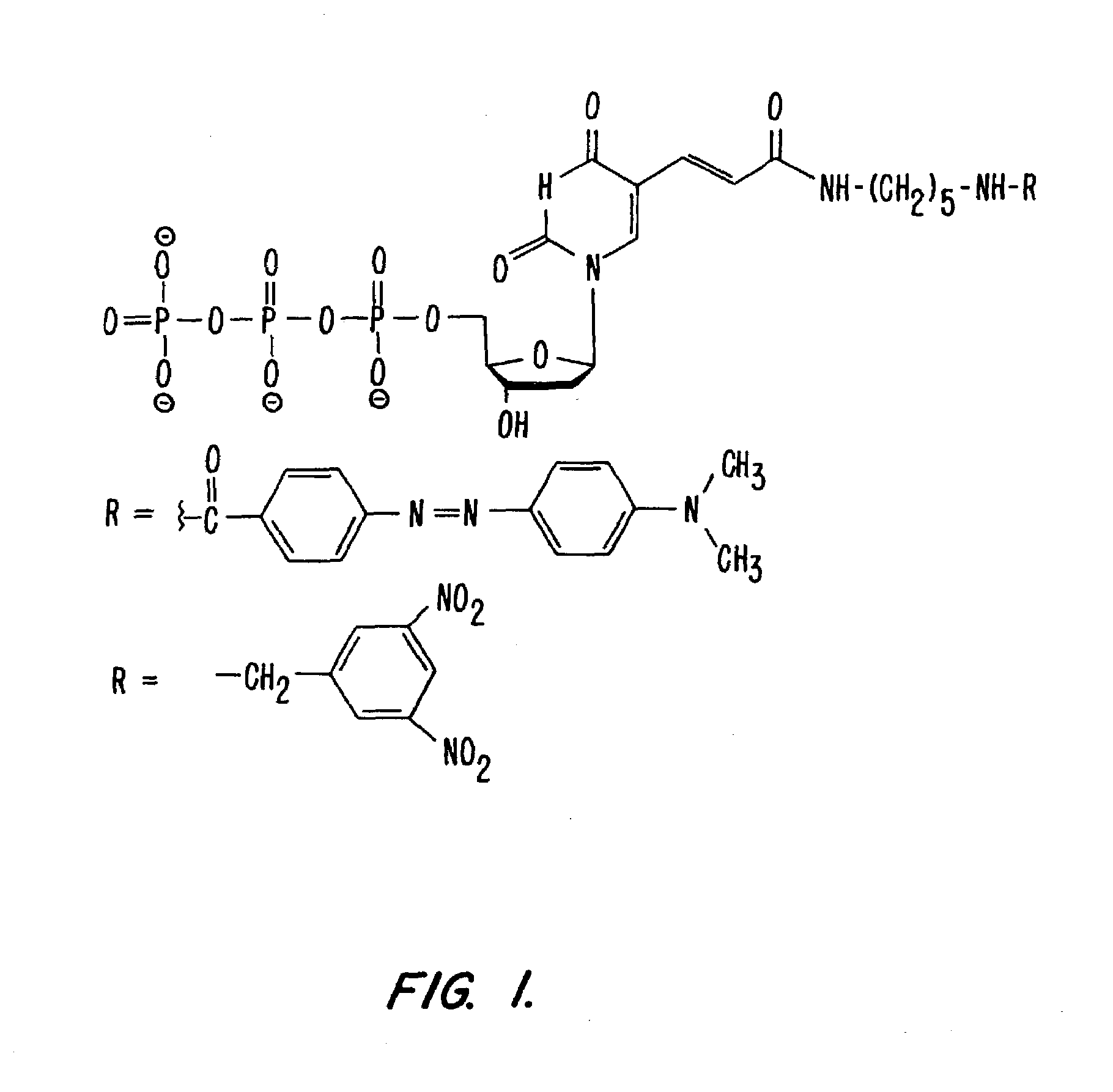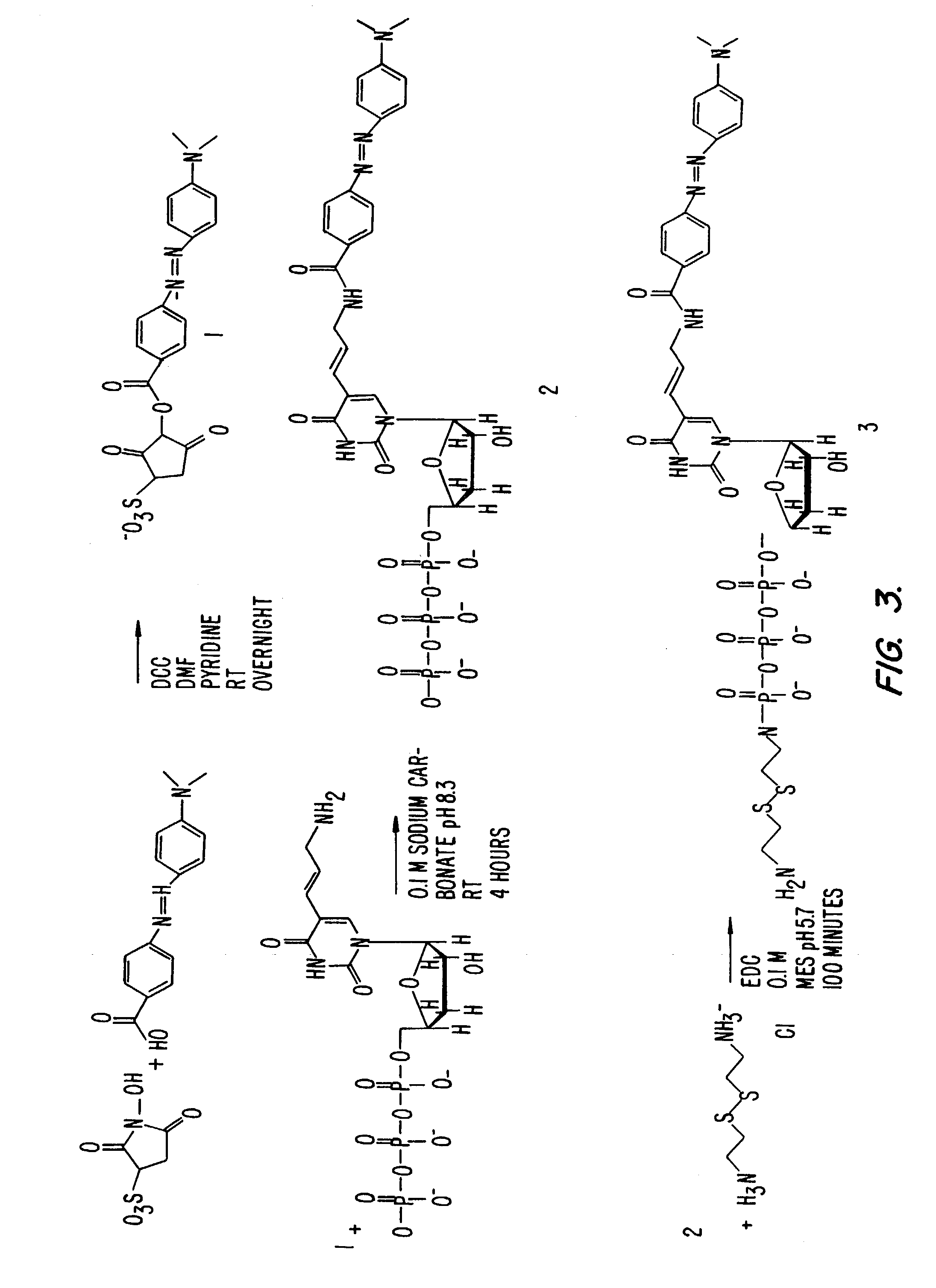System and method for nucleic acid sequencing by polymerase synthesis
a polymerase and nucleic acid technology, applied in the field of sequencing and genotyping nucleic acid, can solve the problems of inability to obtain sequence information, inability to take advantage of continuous detection of ppi release of incorporated nucleotides, and inability to achieve sequence information
- Summary
- Abstract
- Description
- Claims
- Application Information
AI Technical Summary
Problems solved by technology
Method used
Image
Examples
example 1
Polymerase Array
[0087]This example shows how to fabricate an array of nickel nanodots and attach a polymerase to each dot. The required equipment includes a spinner (PWM 202 E-beam resist spinner, Headway Research Inc.), an evaporator (SC4500 thermal e-gun evaporator, CVC Products Inc.), and a scanning electron microscope (Leo 982 with Nabity pattern generator, Leo Electron Microscopy Inc.).
[0088]Clean a 25 mm diameter microscope coverslip on the spinner by spraying alternately with acetone and isopropyl alcohol (IPA) and spinning the last IPA film until dry. Coat the coverslip in the spinner with 0.5 ml of PMMA (poly(methyl methylacrylate), MW 496 kDa, 2% in chlorobenzene), bake on a hoplate at 170 C for 10 min, coat with 0.5 ml of PMMA (MW 950 kDa, 2% in methyl isobutyl ketone [MIBK]), and bake again. Apply the conductive layer by evaporating 100 Angstroms of gold onto the PMMA film in the CVC SC4500. Use the electron microscope to etch the array pattern into the PMMA film using a...
example 2
Two-Color Single-Molecule Imaging Microscope
[0091]The microscope described in FIG. 4 is used to detect single molecule events on the surface of the coverslip obtained in Example 1. The microscope is fitted with a multicolor mixed-gas laser (1) which emits light at tunable wavelengths. The laser beam is first passed through a laser line filter (10) in order to filter out undesirable wavelengths. The unfocused output passes to a fused-silica right angle prism (2), which is located directly under the cover slip (3). The sample (4) molecules sit in a buffer solution on the cover slip.
[0092]Laser light entering the prism is refracted at an angle such that the critical angle between fused-silica and the buffer solution is exceeded. The light is thus completely reflected within the prism, giving rise to a total internal reflection (TIR) evanescent field (9) in the buffer. The area of interest is imaged using a microscope (6) with an objective lens (5) immersed directly in the buffer. Fluor...
example 3
Synthesis of Dual-Labeled Nucleotides
[0094]Example 3A. The synthesis of DABCYL-dUTP-BODIPY TR. (FIG. 3).
[0095]a. Preparation of DABCYL-sulfoNHS
[0096]DABCYL (108 mg, 0.4 mmole; Aldrich 25,019-8 Methyl red) was dissolved in a mixture of dry N,N-dimethylformamide (10 mL; Aldrich 22,705-6) and dry pyridine (96 mg, 1.2 mmole; Aldrich 27,097-0). N-Hydroxysulfosuccinimide (260 mg, 1.2 mmole; Pierce 24510) and N,N′-dicyclohexylcarbodiimide (250 mg, 1.2 mmole; Pierce 20320) were added and the mixture was stirred at 50° C. for 2 hours under a nitrogen atmosphere. The reaction was monitored by TLC (MKC 18F Reversed Phase; Whatman 4803-110; developed in 0.1 M triethylammonium acetate, pH 7, 80% acetonitrile). After dilution with ether, the supernatant was decanted, the product was washed with ether on a filter, dried, and stored dessicated at −20° C.
[0097]b. Synthesis of DABCYL-dUTP
[0098]Aminoallyl-dUTP (10 mg, 20 μmole; Sigma A 0410) was mixed with DABCYL-sulfoNHS (30 mg, 30 μmole; from step A...
PUM
| Property | Measurement | Unit |
|---|---|---|
| Resonance energy | aaaaa | aaaaa |
| Optical properties | aaaaa | aaaaa |
Abstract
Description
Claims
Application Information
 Login to View More
Login to View More - R&D
- Intellectual Property
- Life Sciences
- Materials
- Tech Scout
- Unparalleled Data Quality
- Higher Quality Content
- 60% Fewer Hallucinations
Browse by: Latest US Patents, China's latest patents, Technical Efficacy Thesaurus, Application Domain, Technology Topic, Popular Technical Reports.
© 2025 PatSnap. All rights reserved.Legal|Privacy policy|Modern Slavery Act Transparency Statement|Sitemap|About US| Contact US: help@patsnap.com



